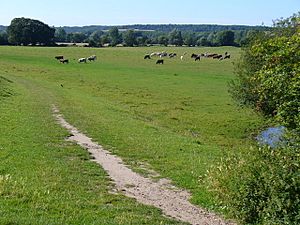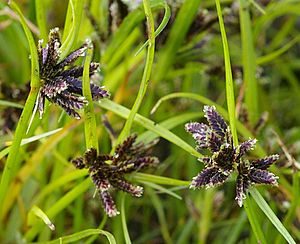Cock Marsh facts for kids
| Site of Special Scientific Interest | |
 |
|
| Area of Search | Berkshire |
|---|---|
| Interest | Biological |
| Area | 18.3 hectares (45 acres) |
| Notification | 1983 |
| Location map | Magic Map |
Cock Marsh is a special natural area covering about 18.3-hectare (45-acre) (that's like 30 football fields!). It's located north of Maidenhead in Berkshire, England. This place is so important for nature that it's called a Site of Special Scientific Interest.
But Cock Marsh isn't just about nature. It's also home to an ancient Round barrow cemetery. For hundreds of years, animals like horses and cattle have grazed here, keeping the land healthy. The National Trust looks after Cock Marsh, making sure it stays special for everyone.
Contents
What Makes Cock Marsh Special?
Cock Marsh is a unique place because it has many different types of grasslands in a small area. You can find chalk grasslands, wet grasslands, and even acidic grasslands here. These different types of land are found near the River Thames.
Animals like horses, cattle, and rabbits help manage the land by grazing. This grazing is important because it keeps the plants healthy. There are also several ponds that sometimes flood and then dry out. This natural cycle helps many different kinds of plants grow. Cock Marsh is also a great spot for watching birds.
Amazing Plants of Cock Marsh
The wet grasslands and ponds at Cock Marsh are home to many different plants. Some of these include marsh arrowgrass, water violets, and marsh pennywort.
One very special plant found here is called Cyperus fuscus, also known as brown galingale. This plant is quite rare and is in danger of disappearing. It grows best in the wet areas of Cock Marsh where grazing animals disturb the ground. Cyperus fuscus is listed as a "vulnerable" plant in Britain and is protected by law.
History of Cock Marsh
Cock Marsh is part of a larger area called the Maidenhead and Cookham Commons. These lands were once owned by the Royal Manor of Cookham. In 1937, a group from the village bought these lands and gave them to the National Trust. The National Trust has been taking care of them ever since.
Ancient Secrets: The Burial Mounds
At Cock Marsh, there's an ancient burial ground called a round barrow cemetery. It's located on the flat land near the River Thames. This cemetery is a "scheduled monument," which means it's a very important historical site that is protected.
The cemetery has four Bronze Age burial mounds. These mounds are like big earth hills where people were buried long, long ago. They were dug up between 1874 and 1877. The mounds were first built in the early Bronze Age. Later, Anglo-Saxons also used them as a burial place.
In the biggest mound, archaeologists found the remains of a woman. They also found things left over from a funeral feast. In one of the smaller mounds, the remains of a small child were discovered. Other finds included pottery, flint tools, animal bones, and parts of a shield and a knife. When it was first built, the largest mound was about 90 feet across and eight feet high. Today, only the largest mound can still be clearly seen.


